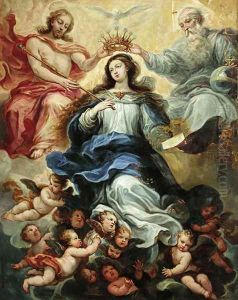Francisco Ricci Paintings
Francisco Rizi, also known as Francisco Ricci, was a significant Spanish painter of the Baroque period. Born in 1614 in Madrid, he was the son of the Italian painter Antonio Rizi, which indicates that his artistic lineage was rooted in a family tradition. His father's influence was instrumental in Francisco's early training and development as an artist.
Rizi's career was marked by his work for the Spanish court, where he served as a painter for King Philip IV. He was heavily influenced by the dramatic and emotive style of Baroque art, which was characterized by strong contrasts of light and shadow, dynamic compositions, and a vivid sense of movement. His works included religious compositions, portraits, and theatrical scenery.
During his lifetime, Rizi held several important positions. He became the official painter of the Madrid town council in 1656, a role that brought him various commissions. Later, he was appointed as a court painter, and in 1674, he became a deputy to the superintendent of the Royal Works and Gardens. His career at the court allowed him to work alongside other prominent artists of the era, such as Diego Velázquez.
Among his notable works are the frescoes in the sacristy of the Escorial Monastery and his contribution to the decoration of the Alcázar of Madrid. His style evolved over time, reflecting the transition from the late mannerist to the early baroque style. He was also known for his skills in perspective, which he applied to his stage designs, making significant contributions to the development of theatrical scenery.
Rizi was also an art theorist and had an interest in optics and perspective, which is evident in his sophisticated use of these elements in his paintings. His work was appreciated not only for its artistic qualities but also for its technical innovations.
Francisco Rizi died in 1685 in Madrid. His legacy lived on through his influence on later generations of Spanish artists, and his paintings can still be admired in various museums and churches in Spain. His contribution to the Spanish Baroque is remembered for its dramatic intensity, technical skill, and the integration of innovative theatrical concepts into his art.
